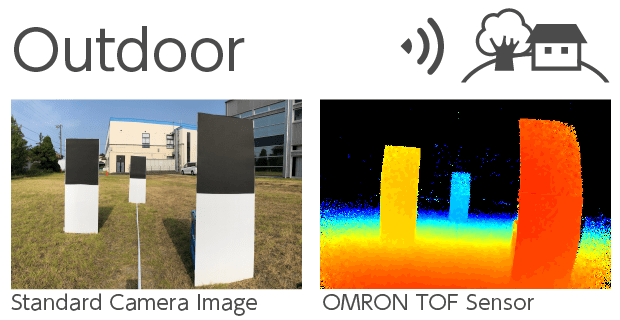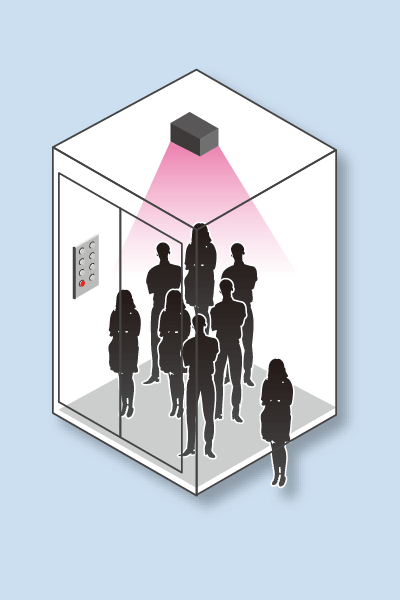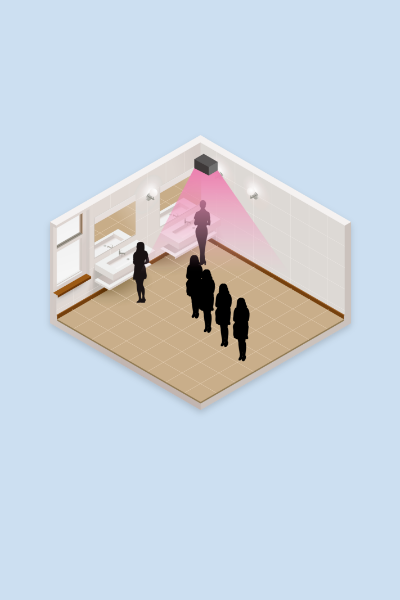Ideal for 3D Distance Measurement Due
to High Ambient Light Immunity and
Flexible Assembly 3D TOF Sensor Module
B5L
Summary
A TOF (Time of Flight) sensor uses the flight time of light to measure the distance to an object. It is equipped with a circuit that is not easily affected by external light thanks to its modulated light system.
OMRON's TOF sensor has four features: ambient light immunity, high precision, long life, and interference prevention. In particular, the feature of ambient light immunity makes it possible to measure the distance of a detected object from near to far, from low reflectance to high reflectance, regardless of whether it is exposed to strong sunlight or not.
It is ideal for applications such as AMR/Service robots and long-term care observation.
What is a TOF Sensor?

Differences Between Conventional 2D Cameras and 3D TOF Sensor
Differences from conventional cameras
The use of extensive distance information enables the sensor to identify its peripheral environment.
-
-
Watch the video here
-
-

Features of OMRON's 3D TOF Sensor
(1) Ambient light immunity
- Using OMRON's B5L TOF Sensor, we compared the measured distances of detected objects indoors and outdoors. Detection objects whose upper half were black and lower half were white, and placed them at 1m, 2m, and 4m, respectively. The black color assumes a low-reflectance object with little reflected light over a long distance, while the white color assumes a high-reflectance object that is easily saturated over a short distance.
- Measurements taken outdoors and indoors with OMRON's B5L TOF Sensor show that there is no significant difference in the measurement distance between black (low reflectance) and white (high reflectance) objects placed at 1 to 4 meters.
In other words, the powerful ambient light immunity ensures stable detection performance of objects with low to high reflectance even in bright places.
-


-
Influence of sunlight 
-
With ambient light -
Without ambient light
(2) High precision
- The distance data of OMRON's B5L TOF Sensor is individually compensated in the process to achieve a high accuracy of ±2% at 2 meters, making it easy for customers to control and process the distance data in their devices.
-
Distance accuracy in angle direction 
-
Distance accuracy 
(3) Long life
-
- Omron’s TOF Sensor has long life equivalent to 5 years under continuous driving.∗1
-
Three measures have been implemented to extend the service life:
- Highly-reliable and long-life components used in Factory Automation applications
- LED light-emitting circuit with LED current under a constant-current circuit configuration that is not affected by the operating environment or power supply voltage
- Ensured heat dissipation by a heat sink to reduce the heat generated by electronic components and keep them below a certain temperature
-

Application examples
When the 3D TOF sensor is used as the eye of a machine, periphery recognition is possible by recognizing the volume and shape of the three-dimensional space, tracking the traffic lines, and understanding the behavior.
The 3D TOF sensor outputs distance data pixel by pixel for periphery recognition.
-
AMR
Service Robot
-
Counting the number of people in the room
Care and Monitoring
-
Logistics and conveyance

Volume and shape measurement

Empty space detection
-
Automatic doors/elevators


Counting people and tracking traffic flows




